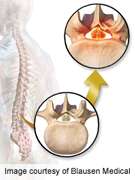For patients hospitalized for lumbar spinal stenosis, the rate of fusions significantly increased and the rate of decompressions significantly decreased from 2004 to 2009 in the United States, according to a study published in the May 15 issue of Spine.
(HealthDay)—For patients hospitalized for lumbar spinal stenosis (LSS), the rate of fusions significantly increased and the rate of decompressions significantly decreased from 2004 to 2009 in the United States, according to a study published in the May 15 issue of Spine.
Hyun W. Bae, M.D., from the Cedars-Sinai Spine Center in Los Angeles, and colleagues retrospectively analyzed 2004 to 2009 data from the Nationwide Inpatient Sample to assess trends in the surgical management of patients with LSS, with and without coexisting spondylolisthesis and scoliosis, in the United States.
The researchers found that, over this period, the number of patients hospitalized with LSS significantly increased (age adjusted population rate, 32.1 to 33.3 per 100,000), the rate of decompressions significantly decreased (from 58.5 to 49.2 percent), the rate of simple fusions significantly increased (from 21.5 to 31.2 percent), the rate of complex fusions remained the same (6.7 percent), the use of bone morphogenetic protein significantly increased (from 14.5 to 33.0 percent of all fusions), and the use of interbody devices significantly increased (from 28.5 to 45.1 percent). In 2009, fusion procedures were performed in 26.2 percent of patients with LSS without instability, 82.7 percent of patients with LSS with coexisting spondylolisthesis, and 67.6 percent of patients with coexisting scoliosis.
"This study demonstrates that the rate of simple fusion surgery has increased for treatment of LSS compared with decompression only," Bae and colleagues conclude.
More information:
Abstract
Full Text (subscription or payment may be required)
Journal information: Spine
Health News Copyright © 2013 HealthDay. All rights reserved.
























